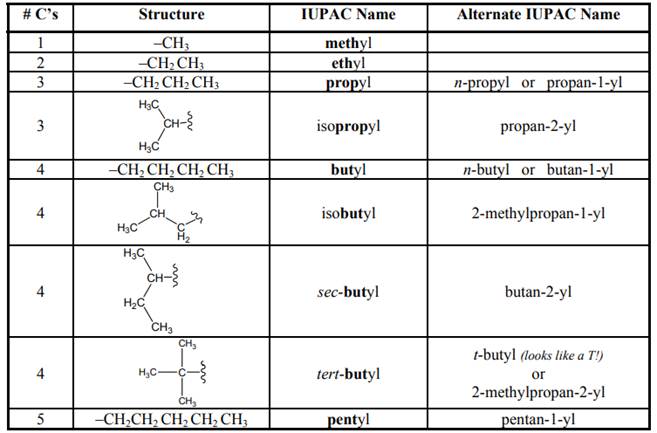
Concept explainers
(a)
Interpretation: The structures of
Concept introduction: Organic compound that consists of only carbon and hydrogen atoms in them are called hydrocarbons. These can either be saturated or unsaturated. Saturated hydrocarbons are compounds that contain only single bonds between them while hydrocarbons with multiple bonds are called
(b)
Interpretation: The structures of
Concept introduction: Organic compound that consists of only carbon and hydrogen atoms in them are called hydrocarbons. These can either be saturated or unsaturated. Saturated hydrocarbons are compounds that contain only single bonds between them while hydrocarbons with multiple bonds are called unsaturated hydrocarbons. Alkanes are saturated hydrocarbons with general formula of
(c)
Interpretation: The structure of
Concept introduction: Organic compound that consists of only carbon and hydrogen atoms in them are called hydrocarbons. These can either be saturated or unsaturated. Saturated hydrocarbons are compounds that contain only single bonds between them while hydrocarbons with multiple bonds are called unsaturated hydrocarbons. Alkanes are saturated hydrocarbons with general formula of
(d)
Interpretation: The structure of
Concept introduction: Organic compound that consists of only carbon and hydrogen atoms in them are called hydrocarbons. These can either be saturated or unsaturated. Saturated hydrocarbons are compounds that contain only single bonds between them while hydrocarbons with multiple bonds are called unsaturated hydrocarbons. Alkanes are saturated hydrocarbons with general formula of
(e)
Interpretation: The structure of
Concept introduction: Organic compound that consists of only carbon and hydrogen atoms in them are called hydrocarbons. These can either be saturated or unsaturated. Saturated hydrocarbons are compounds that contain only single bonds between them while hydrocarbons with multiple bonds are called unsaturated hydrocarbons. Alkanes are saturated hydrocarbons with general formula of
(f)
Interpretation: The structure of
Concept introduction: Organic compound that consists of only carbon and hydrogen atoms in them are called hydrocarbons. These can either be saturated or unsaturated. Saturated hydrocarbons are compounds that contain only single bonds between them while hydrocarbons with multiple bonds are called unsaturated hydrocarbons. Alkanes are saturated hydrocarbons with general formula of
(g)
Interpretation: The structure of
Concept introduction: Organic compound that consists of only carbon and hydrogen atoms in them are called hydrocarbons. These can either be saturated or unsaturated. Saturated hydrocarbons are compounds that contain only single bonds between them while hydrocarbons with multiple bonds are called unsaturated hydrocarbons. Alkanes are saturated hydrocarbons with general formula of
(h)
Interpretation: The structure of
Concept introduction: As per IUPAC recommendations longest chain found in a continuous manner in a branched molecule is chosen as parent chain. Any substituent that protrudes from certain carbon of parent chain is termed side chain. In hydrocarbon with branches the chief side chains are illustrated below:

The numeral present before “yl” indicate the carbon number of side chain that is used to bind as the side chain to parent chain.
(i)
Interpretation: The structure of
Concept introduction: Organic compound that consists of only carbon and hydrogen atoms in them are called hydrocarbons. These can either be saturated or unsaturated. Saturated hydrocarbons are compounds that contain only single bonds between them while hydrocarbons with multiple bonds are called unsaturated hydrocarbons. Alkanes are saturated hydrocarbons with general formula of
(i)
Interpretation: The structure of
Concept introduction: The convention followed for IUPAC nomenclature of cyclic alkanes is as follows:
- If even a single ring is found in a molecule, this ring is regarded as the parent chain.
- Alkyl groups attached to rings are assigned smallest priority and number and it is followed in cyclic manner toward the closest group.
- If two alkyl; group happen to be same the smallest priority number is assigned alphabetically.
Trending nowThis is a popular solution!

Chapter NW1 Solutions
Organic Chemistry: A Guided Inquiry
- presented by Morallen Lig Intermine the hand product for the given mution by adding atoms, bonds, nonhonding diarion panda скуль Step 3: Comp the draw the product Step 2: Agama workup Compithe 429 ملولةarrow_forwardReaction A 0,0arrow_forwardpresented by Morillon Leaning Predict the organic product for the min кусур HSC Adithane carved arnown to come than that to the condon slchroruis in acid in in aquishri with ноюarrow_forward
- 6.15PM Sun Mar 30 K Draw the major product of this reaction. Include any relevant stereochemistry. Ignore inorganic byproducts. Problem 1 of O H [PhзPCH2CH3]*C|¯ NaH Drawing > Q Atoms, Bonds and Draw or tap a nearrow_forward8:17 PM Sun Mar 30 Draw the major product of this reaction. Ignore inorganic byproducts. HSCH2CH2CH2SH, BF3 Probler Drawing Ato Bonds Clarrow_forwardpresented by Mr L How the coprion. (Il Done in no wraction, dew the starting redential) доarrow_forward
- 8:16 PM Sun Mar 30 K Draw the major product of this reaction. Ignore inorganic byproducts. Proble 1. CH3MgBr 2. H3O+ F Drawingarrow_forwardо но оarrow_forwardName the major organic product of the following action of 4-chloro-4-methyl-1-pentanol in neutral pollution 10+ Now the product. The product has a molecular formula f b. In a singly hain, the starting, material again converts into a secule with the molecular kormula CIO. but with comply Draw the major organic structure inhalationarrow_forward
- Macmillan Learning Alcohols can be oxidized by chromic acid derivatives. One such reagent is pyridinium chlorochromate, (C,H,NH*)(CICTO3), commonly known as PCC. Draw the proposed (neutral) intermediate and the organic product in the oxidation of 1-butanol by PCC when carried out in an anhydrous solvent such as CH₂C₁₂. PCC Intermediate OH CH2Cl2 Draw the intermediate. Select Draw Templates More с H Cr о Product Draw the product. Erase Select Draw Templates More H о Erasearrow_forwardIf I have 1-bromopropene, to obtain compound A, I have to add NaOH and another compound. Indicate which compound that would be. A C6H5 CH3arrow_forwardProvide the reagents for the following reactions.arrow_forward
 Organic Chemistry: A Guided InquiryChemistryISBN:9780618974122Author:Andrei StraumanisPublisher:Cengage Learning
Organic Chemistry: A Guided InquiryChemistryISBN:9780618974122Author:Andrei StraumanisPublisher:Cengage Learning
